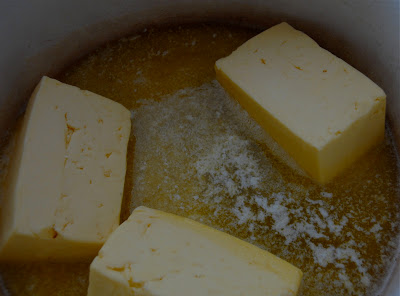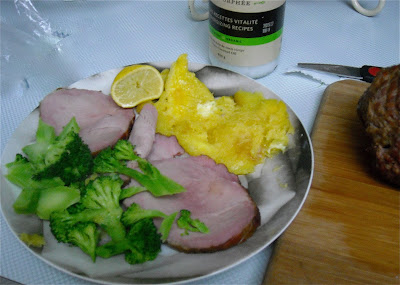I've struggled with an autoimmune condition for years. It was through this pain that I started looking at the things I could control. I thought my
vegetarian diet was the epitome of health. When that started to fail, I moved on to the land of vegans. That seemed to make me feel better for a while, until it did not. I lost huge amounts of muscle and was constantly sick. My adrenals were a mess and the pain was ever present. My hair was dry and thinning, I was 25lbs underweight, cranky and exhausted.
Card carrying member, my friends.
Then, in walked my husband with his chiseled 8 pack and big ole' manly man arms. Hmm.. I want muscle too, I thought. I decided to reevaluate. I started adding wild caught fish and organic chicken into my diet. I felt better, not great, just better. I was eating all the "healthy" foods I needed to in order to be lean and mean. It was chicken breast-o-rama! Egg whites, and zero fat yoghurt, and protein powder by the gallon. But no worries, I knew I needed some fat so I added a couple of teaspoons (measured of course) of flax oil to my salad. Sigh. I feel sad for that hungry girl. I looked good. I felt like shit.
Hubby's aforementioned manly man arms. Oh baby, you still do it for me, even without the butt striations.
It was around this time that I was introduced to the
Weston A. Price Foundation. My husband and I attended a presentation by
Sally Fallon-Morrell. We walked away
not convinced. It wasn't that what she said was lacking in credibility or science, it's just that we were bodybuilders damn it! and that woman put down our holy grail - protein powder! We loved us some protein powder! How could we ever get the five gazillion grams of protein we needed to build our precious muscles without it? And what was that she said about meat?! Eat fatty meat? That lady was Caraaaazeeee! Looking around the room at the people espousing the virtues of sourdough bread and raw dairy, well... let's just say that there wasn't a lot of athletes. Keep in mind, this was quite a few years ago, testosterone and vanity ran strong. Still, we left the presentation with a field of seeds planted in our wee brains. The big one:
fat is good. That mind blowing tidbit set us off on a path of research and experimentation.
It was around this time that I noticed that my diet was directly related to the constant pain in my body.
Certain foods were tantamount to swallowing an inflammation pill. My beloved protein powder betrayed me. The egg whites I ate by the half dozen,
daily, now prevented my fingers from bending. Potatoes caused my lower back to seize up when I bent over to lift up one of my children. And so it went. I removed food after food after food. I removed everything except the whole grains I loved because we all know whole grains are necessary for good health and good health is what this girl wanted.
From there, we expanded our knowledge on the sources of our foods. We started purchasing all of our animal products from farmers that were raising their animals on grass from organic pastures. We bought our eggs from farmers that didn't feed their chickens soy and allowed their birds to roam. We became aware of the importance of ruminants on grasslands for the sustainability of our land.
Regardless of what foods I removed, the pain only faded, never completely left. I would notice it during my workouts when my body wouldn't move the way I wanted it to, or in the inflammation that would unveil itself 'randomly'. During this time, I never once stopped to consider the health of my digestive tract. I continued to live, me and my pain, hand in hand. Then, floating down from the heavens came the book, "
Gut and Psychology Syndrome (GAPS)" by
Dr. Natasha Campbell-McBride.
My kefir grains that multiply faster than rabbits. Kefir is one of those cultured foods that are teeming with probiotics and is really easy to make. Raw milk, grains, and a day or so for culturing is all it takes. You can learn everything you ever wanted to know about kefir at Dom's site.
I read Dr. Campbell's book and then I did it. Suddenly, light bulbs were going off all over the place. The years of tetracycline my doctor put me on as a teenager may have had an affect on my gut. Yah, just maybe.
Being a vegetarian and a vegan only served to accelerate my deteriorating health. Eating refined foods (egg whites/protein powders) prevented my body from healing and, in fact, created food intolerances. I learned about the importance of cultured and fermented foods. It's still astonishing to know how healing these foods are, but how lacking they are in our diets. I also learned about the problems with grains, something that I further expanded my knowledge on and decided to eliminate from our family's diet. It was definitely the right choice. The kids noticed their thinking was clearer and we noticed that they weren't getting sick nearly as much. Keep in mind, we weren't giving up refined grains here. I was soaking and sprouting all of our grains before we ate them. I once heard Robb Wolf draw a parallel between soaking grains and diluting a poison - it's still a poison. I totally agree.

Following GAPS brought me to a pain-free place in my life for the first time in over a decade. I healed my gut with bone broth soups and with a lot of help from my gut-friendly buggy friends. In return, my body moved and bent, lifted and leaped with ease. Probiotics were instrumental in my regained health. Let's be clear, these are probiotics found in naturally fermented and cultured foods, not in a pill. Pills never helped me. If you're the type of person that needs science to back up the anecdotes, do a quick Google Scholar search on fermented and cultured foods to see the boat-load of studies on the positive health effects of these foods. I can tell when we let the consumption of our fermented veggies slide.
Nightshades are poison to me. Grains are garbage.
Nuts bring on cramps, even when I soak them for 24 hours, before dehydrating them.
My kefir, ready for drinking. I think it's so pretty when it gets all squiggly on the top.
Since the era of GAPS, we've continued to research and evolve our diets. We are fascinated by nutrition and we are blessed by the relationships we have developed with our local farmers. Our children, now 18, 14, and 8 know what it is to live in pain-free bodies. They have eaten this way so long that it's just how they eat. They recognize the disfunction in our society's relationship with empty foods. It's a foundation they will go out into the world with. I worry for the children that grow up never knowing what it is to feel good in their bodies and clear in their minds.
Fermenting veggies. I make a few different types at once. Once they're done fermenting, they will keep forever in the fridge. Combined with some good meat and fat, they make the perfect, fast lunch.
Fermented vegetables, grass fed meats, soy-free pastured eggs, healthy animal fats, grass fed butter, cultured raw dairy from grass-fed cows, fermented veggies, and bone broths make up our family's diets. Today, I live pain free. That sounds like a light statement, but if you have ever lived with chronic pain, you will understand how huge that is. If I deviate from my diet, the pain comes. It's that simple. I have the power to live in a body that is not inflamed. I wish that feeling of empowerment to every soul roaming this planet, housed in their beautiful bone cage.












































